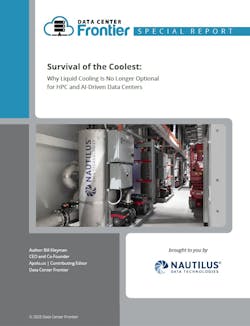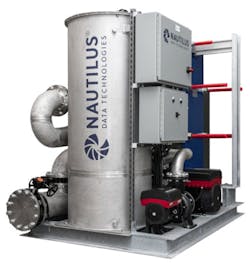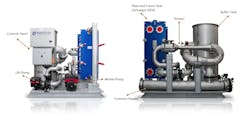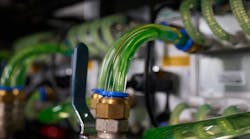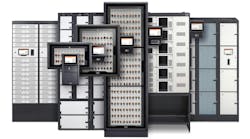The Liquid Cooling Designs Making an Impact Today
We continue our article series on the current state of cooling in data centers, how organizations are adapting their cooling strategies, and why liquid cooling is no longer a “nice to have” but a necessity. This week, we’ll explore the liquid cooling designs making an impact today.
The workloads driving our digital world today look nothing like those of the past. AI models, HPC, and real-time analytics are pushing density, efficiency, and scalability to entirely new levels. The challenge? Traditional cooling strategies weren’t designed for this level of power demand. As rack densities rise, so do the limitations of air cooling.
Here’s the reality: Liquid cooling isn’t just an alternative; it’s a necessity where density exceeds the capabilities of air. Compared to air, water has a heat-carrying capacity 3,500 times higher and a thermal conductivity 24 times greater. That’s a massive difference in how efficiently heat can be removed from high-powered servers. As density increases, liquid cooling’s ability to transfer heat directly from the source makes it the superior choice for AI-driven environments, large-scale HPC, and next-gen cloud workloads.
But liquid cooling isn’t a one-size-fits-all solution. There are different approaches, each suited to specific environments and operational requirements. As we explore the next generation of data center cooling, understanding how and when to implement liquid cooling will be critical for optimizing efficiency and performance at scale. To that extent, it’s time to explore the new innovations around liquid cooling and the impacts on your data center.
Nautilus Core IP: Negative Pressure Vacuum-Based System
What sets Nautilus apart in the realm of liquid cooling is its ability to operate in sub-atmospheric (vacuum- based) conditions, either fully or in part, depending on system pressure requirements and environmental constraints. This adaptive capability is anchored by a patented leak prevention system (LPS), which not only protects IT equipment by eliminating leak risks, but also broadens the range of operational pressures across which the system can perform reliably. Let’s dive a bit deeper into this core IP and see how it can impact today’s data center ecosystems.
- Full or Partial Vacuum Operation: Tailored for Pressure Flexibility. In some definitions, hybrid operating modes refer to the use of liquid and air in an environment. In this case, it’s a bit different.
Hybrid operating modes allow the system to intelligently switch between sub-atmospheric and positive pressure configurations based on workload intensity, ambient temperature, and overall system performance needs. This adaptability ensures operators can fine-tune thermal management strategies based on real-time conditions.
Nautilus systems offer flexible operation and are capable of running in either full vacuum mode or a hybrid pressure setup, depending on your data center’s specific requirements. In full vacuum operation, the LPS guarantees complete leak prevention, ensuring zero leakage by allowing only air intrusion if a breach occurs. When operating in hybrid mode, the system provides robust leak mitigation, significantly reducing the risk of coolant escape. Both modes leverage proactive air-removal capabilities, supported by an advanced buffer tank system that efficiently separates and vents air, maintaining consistent system performance and integrity.
This flexibility allows Nautilus systems to operate across a broad range of differential pressures, seamlessly adapting to workload, facility design, and coolant source — be it freshwater, graywater, or seawater.
- Intelligent Architecture and System Integration. Nautilus liquid cooling systems are built around a highly intelligent, integrated architecture. Each CDU is equipped with advanced sensors, programmable logic controllers (PLCs), variable frequency drive (VFD) pumps, and API-ready interfaces for seamless integration with DCIM and BMS platforms. This enables continuous, autonomous optimization of temperature, flow, and pressure based on workload demand.
This level of automation and system intelligence allows data center operators to reduce manual intervention, improve energy efficiency, and enhance visibility into cooling operations. As a vendor-agnostic platform, Nautilus’ systems also integrate easily with diverse infrastructure environments, supporting both traditional facility water systems (FWS) and natural water sources.
- Scaling to Multi-Megawatt Environments. HPC and GenAI are no longer niche workloads — they are quickly becoming the new baseline. These workloads often require rack densities that far exceed the limits of traditional cooling strategies. Nautilus’ EcoCore COOL addresses this challenge head-on, delivering up to 4,000 kW of cooling capacity per unit in hybrid mode and supporting multi-megawatt-scale deployments with up to N+2 redundancy.
Beyond raw power, these systems operate with superior efficiency. Their intelligent control systems dynamically adjust flow and pressure to minimize energy consumption, translating into measurable power savings across the facility. By eliminating the inefficiencies associated with air movement and reducing dependency on chillers, operators can achieve significant improvements in both PUE and operational costs.
- Containerized Cooling and the Rise of CDU Skids. As demand for rapid deployment grows, so does the need for modularity. Nautilus is leading the shift toward containerized and skid-mounted CDU systems, making it possible to deploy high-capacity liquid cooling infrastructure quickly and efficiently. These plug-and-play systems simplify site integration, bypass supply chain delays, and reduce on-site construction timelines.
At the core of this modular approach is the CDU, now more advanced and flexible than ever. The EcoCore COOL supports a wide range of liquid cooling methods, including direct-to-chip, immersion, rear-door, and traditional hot aisle containment. It also offers broad compatibility with freshwater, seawater, and glycol-based systems, enabling data centers to select the most sustainable and locally available options.
EcoCore COOL: Facility-Scale Cooling Redefined
The EcoCore COOL represents a leap forward in liquid cooling infrastructure. Unlike in-row CDUs, the EcoCore COOL unit is designed for data hall-scale deployment, offering centralized cooling that supports entire white spaces. With scalable, redundant configurations and intelligent flow control, this system enables data centers to support dense AI and inference workloads while maintaining uptime, safety, and efficiency.
Notable features include:
- Patented Leak Prevention System (LPS) for sub-atmospheric operation and leak- proof reliability.
- Flexible Approach Temperature Differential (ATD) from 1°C to 15°C to support varying environmental and thermal conditions.
- Modular parallel CDU operation to support N+1 or N+2 redundancy, scale cooling capacity, and maximize uptime — enabling facilities to expand performance and resiliency in lockstep as workloads grow.
- Zero water consumption when connected to natural water sources — supporting broader sustainability goals.
With up to 4 MW per unit and built-in support for diverse cooling technologies, the EcoCore COOL is a future-ready solution that meets the thermal demands of AI, HPC, and next-gen digital infrastructure, without compromising on safety or speed of deployment.
Download the full report, Survival of the Coolest: Why Liquid Cooling is No Longer Optional for HPC and AI-Driven Data Centers, featuring Nautilus Data Technologies, to learn more. In our next article, see these innovations in action!
About the Author


